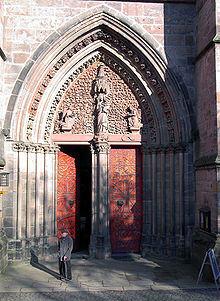- St. Elisabeth's Church (Marburg)
-
St. Elisabeth's Church is a religious building in Marburg, Germany, built by the Order of the Teutonic Knights in honour of Elisabeth of Hungary. Her tomb made the church an important pilgrimage destination in the late Middle Ages.
Contents
Architecture
The church is one of the earliest purely Gothic churches in German-speaking areas, and is held to be a model for the architecture of Cologne Cathedral. It is built from sandstone in a cruciform layout. The nave and its flanking aisles have a vaulted ceiling more than 20 m (66 ft) high. The triple quire consists of the Elisabeth quire, the High quire and the Landgrave quire. The crossing is separated from the nave by a stone rood screen. In earlier times, the front part of the church had been reserved for the Knights of the Order. The Elisabeth Church has two towers with an approximate height of 80 m (263 ft). The northern one is crowned by a star, the southern one by a knight. The Elisabeth Church served as an inspiration for St. Paul's Church of Strasbourg.
The Gothic shrine of Saint Elisabeth is the most important treasure of the church, but other pieces of sacral art are also exhibited.
History
Construction started in 1235, the year Elisabeth was canonized. The church was consecrated in 1283. However, the towers were not finished until 1340. The church was property of the Order of the Teutonic Knights; some buildings of the Order still exist near the church, among them the Deutschhausgut, which now houses the mineral collection and the department of geography of the Philipps University of Marburg.
Until the 16th century, the Landgraves of Hesse were buried in the church. In the context of the Reformation, Philip I, Landgrave of Hesse had the remains of Saint Elisabeth removed, in order to oust the pilgrims from the Protestant city of Marburg. Today, relics of Elisabeth can be found in the Elisabeth convent in Vienna, in the City Museum in Stockholm and in Košice.
Most of the monks converted to Protestantism during the 16th century, and the church was used for Protestant services. For a short time at the beginning of the 19th century, both Catholic mass and Protestant communion were celebrated in separate parts of the church.
After World War II, former German president Paul von Hindenburg and his wife were buried in the Elisabeth church, after the evacuation of their remains from the Tannenberg memorial in former East Prussia.
Current developments
In order to start a long-needed renovation of the church and the remodeling of its immediate neighborhood, the Stiftung Heilige Elisabeth foundation was established in 2004 and supports the city of Marburg and the Protestant Church of Hesse-Kassel and Waldeck in the financing of the repair measures.
See also
References
- Hermann Bauer: Sankt Elisabeth und die Elisabethkirche zu Marburg. Marburg, Hitzeroth 1990 ISBN 3-89616-031-1 (German)
- Andreas Köstler: Die Ausstattung der Marburger Elisabethkirche. Zur Ästhetisierung des Kultraums im Mittelalter. Berlin, Reimer 1995 ISBN 3-496-01134-3 (German)
- Eberhard Leppin: Die Elisabethkirche in Marburg an der Lahn. Königstein, Langwiesche 1999 ISBN 3-7845-2913-5 (German)
External links
- St. Elisabeth's Church (German)
Categories:- Buildings and structures in Marburg
- Gothic architecture in Germany
- Churches in Hesse
Wikimedia Foundation. 2010.




